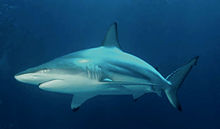| Blacktip shark | |
|---|---|

| |
| Scientific classification | |
| Domain: | Eukaryota |
| Kingdom: | Animalia |
| Phylum: | Chordata |
| Class: | Chondrichthyes |
| Subclass: | Elasmobranchii |
| Subdivision: | Selachimorpha |
| Order: | Carcharhiniformes |
| Family: | Carcharhinidae |
| Genus: | Carcharhinus |
| Species: | C. limbatus
|
| Binomial name | |
| Carcharhinus limbatus (J. P. Müller & Henle, 1839)
| |

| |
| Range of the blacktip shark | |
| Synonyms | |
| |
The blacktip shark (Carcharhinus limbatus) is a species of requiem shark, and part of the family Carcharhinidae. It is common to coastal tropical and subtropical waters around the world, including brackish habitats. Genetic analyses have revealed substantial variation within this species, with populations from the western Atlantic Ocean isolated and distinct from those in the rest of its range. The blacktip shark has a stout, fusiform body with a pointed snout, long gill slits, and no ridge between the dorsal fins. Most individuals have black tips or edges on the pectoral, dorsal, pelvic, and caudal fins. It usually attains a length of 1.5 m (4.9 ft).
Swift, energetic piscivores, blacktip sharks are known to make spinning leaps out of the water while attacking schools of small fish. Their demeanor has been described as "timid" compared to other large requiem sharks. Both juveniles and adults form groups of varying size. Like other members of its family, the blacktip shark is viviparous; females bear one to 10 pups every other year. Young blacktip sharks spend the first months of their lives in shallow nurseries, and grown females return to the nurseries where they were born to give birth themselves. In the absence of males, females are also capable of asexual reproduction.
Normally wary of humans, blacktip sharks can become aggressive in the presence of food and have been responsible for a number of attacks on people. This species is of importance to both commercial and recreational fisheries across many parts of its range, with its meat, skin, fins, and liver oil used. It has been assessed as Vulnerable by the IUCN, on the basis of its low reproductive rate and high value to fishers.
- ^ Rigby, C.L.; Carlson, J.; Chin, A.; Derrick, D.; Dicken, M.; Pacoureau, N. (2021). "Carcharhinus limbatus". IUCN Red List of Threatened Species. 2021: e.T3851A2870736. doi:10.2305/IUCN.UK.2021-2.RLTS.T3851A2870736.en. Retrieved 12 November 2021.
